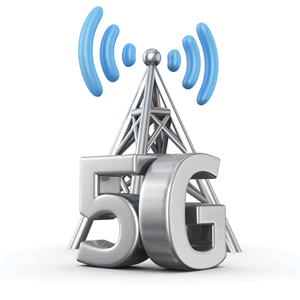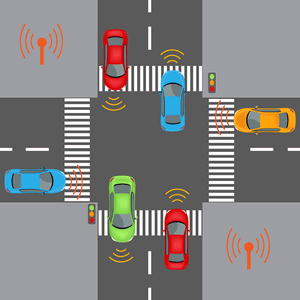5G’s Threefold Mandate
The challenges of high-bandwidth low-latency wireless for autonomous technology, high data volumes for media, and support for the Internet of Things are shaping the next generation of wireless.
 While each generation of mobile technology has been developed to tackle new challenges, the current generation in development – the 5G standard – will be designed to meet challenges scarcely imagined in the earlier eras of wireless technology. Until digital mobile communication was introduced with the 2G standard and technologies like GPRS and EDGE, the biggest challenges facing innovators in mobile was improved clarity for voice calls (for which the first digital technologies, like encryption, were developed). The digital cell phone (and especially the smartphone) changed all that. Not only were voice calls now transmitted and encrypted digitally, but the cell phone was fundamentally transformed from a mobile version of the telephone into a platform for digital data connectivity and internet access.
While each generation of mobile technology has been developed to tackle new challenges, the current generation in development – the 5G standard – will be designed to meet challenges scarcely imagined in the earlier eras of wireless technology. Until digital mobile communication was introduced with the 2G standard and technologies like GPRS and EDGE, the biggest challenges facing innovators in mobile was improved clarity for voice calls (for which the first digital technologies, like encryption, were developed). The digital cell phone (and especially the smartphone) changed all that. Not only were voice calls now transmitted and encrypted digitally, but the cell phone was fundamentally transformed from a mobile version of the telephone into a platform for digital data connectivity and internet access.
This innovation reached a turning point with the introduction of the iPhone in 2007, and today billions of people have access to the Internet via smartphones. In fact, today’s smartphones form the foundation of the forthcoming Internet of Things, the network of sensors embedded in nearly everything that will feed data to analytics applications. Providing information derived from this vast array of sensors, the IoT will change forever the way private industry, government, and institutions like science and medicine make decisions and new discoveries.
Different Technologies, Different Needs
While the shift to digital was undoubtedly a milestone in wireless communications, the shift to supporting the Internet of Things and technologies like autonomous vehicles and connected infrastructure will be an even greater marker in the history of mobile technology and civilizations. In the forthcoming decades, mobile technology will be relied upon for high-throughput, low-latency applications like communications that support autonomous vehicles and manage entire transportation networks. At the same time, it will be relied upon to power the Internet of Things, which will require a completely different kind of network.
The IoT’s millions or even billions of sensors will all need to be connected, but with latency and bandwidth being comparatively minor considerations; a sensor reporting temperature once per minute, for example, need only send its data when it’s convenient for the network, and the accuracy and timeliness of each individual piece of data is not a matter of life or death. Autonomous vehicles and connected busses and trains, not to mention military applications that may also utilize new wireless technologies, will need to transmit data quickly and reliably with life-or-death stakes. The challenge facing innovators in mobile technology today is how to combine the low-latency and high-bandwidth requirements of autonomous and connected infrastructure technology with the low-latency, low-bandwidth requirements of supporting billions of sensors.
5G is Underway
 These challenges are more than merely academic questions; they are representative of the mobile technology in development today. In July, the FCC set aside RF spectrum bandwidth for industry and researchers to use to develop the technology of 5G. Industry is tasked with developing the technology by the early 2020s, which includes mandates for supporting the Internet of Things and higher bandwidth and lower latency for critical applications.
These challenges are more than merely academic questions; they are representative of the mobile technology in development today. In July, the FCC set aside RF spectrum bandwidth for industry and researchers to use to develop the technology of 5G. Industry is tasked with developing the technology by the early 2020s, which includes mandates for supporting the Internet of Things and higher bandwidth and lower latency for critical applications.
While a variety of communications technologies are being included in projects around autonomous vehicles and connected infrastructure, mobile technology is poised to take center stage. With the underlying infrastructure already in place and consumer applications already widely available through smartphones, it’s no surprise that research firms like ABI Research project an improved cellular network as being central to services on the horizon like robotic carsharing, both for vehicle connectivity and user interaction. In addition, the 5G standards are geared to meet both the technical challenges of running something like an autonomous vehicle network, as well as continuing to serve consumers’ needs for data-heavy services like streaming video.
A Foundation of Sensors
Autonomous vehicles and the Internet of Things are the primary drivers of 5G technology, and while we may see services like robotic carsharing in the next five years (analysts project the early 2020s), in the immediate future the fruits of improving wireless technology will continue to bolster the foundation of the Internet of Things. Wearable technology will continue to expand, both for consumers and special applications like the military, all the while enriching density of sensors and their data in the world. Consumer products and infrastructure projects will also continue to include sensors and increase the density of available information, further reducing structural barriers to future projects.
The immediacy of value that can be derived from this thickening forest of sensors and the data they deliver will provide the incentive for the (currently) more fantastical technologies, like robotic carsharing, that are on the slightly more distant horizon. In this one growth area, business is finding the incentive to bring to consumers technologies that formerly were the purview only of the military and the logistics and transportation industries, all to be made possible with the next generation of wireless technology as its foundation.
Neil Shurtz is a contributor to ConnectorSupplier.com based in San Francisco. As a freelancer and in his work in public relations for high-tech companies, he has written about technology in the oil and gas, aerospace, and manufacturing industries. Shurtz specializes in framing complex and niche technical topics in a broader social context.
[related_posts limit=”10″]




